
Ruffled, Rakish, Feathered, Flown
by Trileigh Tucker
Somewhere in the universe,
in the gallery of important things,
the babyish owl, ruffled and rakish,
sits on its pedestal.
—Mary Oliver
“The
baby owl fell again!” my neighbor Veronica said. My heart sank. “But
he’s okay,” she quickly reassured me. “Parks and Rec got their chief
carpenter to come out and make a platform for him. I’ll show you where
it is.”
Maybe now I’d finally get a look at the owlet she kept telling me
about. I’d often brought my geology students to my neighborhood park to
study its glacial layers and beach processes, but its avian life was
less familiar to me.
Veronica, one of the “forest friends” I often encounter in our park,
described the huge cherry-picker carrying the tiny owlet in a cardboard
box to his custom-designed platform. “You should have seen it!” she
said, her laughter shaking her long, sandy hair out of its bun. “Here
are all these big guys with their vests and their yellow hard hats,
barking orders out to each other. ‘Hold it—steady—up we go—don’t bump
the owlet box—DON’T BUMP HIM!—Okay, good—set him down
gently—gently—GENTLY, I SAID!!—he’s on the platform? Okay, come on back
down…’ And then the whole crew gave each other high-fives. All for a
little baby owl!”
Pushing back my floppy field-geologist hat for better vision,
binoculars and camera ready in their respective holsters, I craned my
neck to see the platform, thirty feet up in a sequoia. Unlike the baby’s
original nest nearby, his new home was rimmed with two-by-fours so that
the owlet wouldn’t fall so easily.
My first glimpse of the baby revealed a white fluffball with big dark eyes, peering curiously over the edge of his new home. As I moved around the base of the tree with my camera, he’d scurry over to the other side of the platform to keep a wary eye on me.
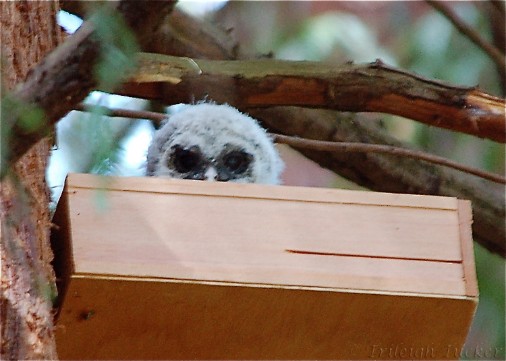
A
few days later, Veronica told me she’d once again found the owlet on
the ground— somehow he’d managed to fall from the walled platform.
“I got him to climb onto this big stick,” she said. “Then I lifted
him up to a tree branch as high as I could reach. Don’t want any dogs to
get him.” The Parks Department was kind enough to once more bring back
the cherry-picker.
We christened the baby “Wollet,” as a diminutive of Wol, Christopher Robin’s owl friend in Winnie-the-Pooh.
On an early evening walk a week later, I came across Wollet
struggling against the bark of a sequoia near his home tree, within dog
reach. Thinking of Veronica, I got a big branch and tried to persuade
him to climb onto it so I could get him above ground level. As I came
near with the stick, Wollet hissed at me, then started making clicking
and snapping sounds.
“What are you doing?” asked one of the curious people who wandered by, accompanied by even more curious dogs.
“This little owlet fell down out of a tree. Does anyone have a cellphone?” I asked the group that had begun to gather.
“Yeah, I know a good shelter. I’ll call them. They don’t take your
animals away,” said a woman with a hard face and a soft heart. Her dog,
softer in face, strained at the leash toward the owlet.
“Thanks. Would you mind keeping your dog away? The little guy gets
really stressed around dogs.” The woman moved courteously away and
dialed.
No answer: not surprising on a Saturday evening. A group gathered to
watch the drama— including one of Wollet’s parents, who flew in and
perched on a nearby branch, its eyes noting the exact position and
trajectory of every dog.
A man and his family walked up. He grimaced. “Oh, for God’s sake.
Just leave him alone,” he grumbled. “He knows what he’s doing. I grew up
around owls in eastern Washington. That’s how they develop their
muscles—they fall out of trees and then climb back up.”
He clearly wanted to walk on, but his wife and daughter, riveted by Wollet’s drama, stayed right where they were. “You do-gooder city people,” he muttered. “Don’t know a thing about nature and end up causing more trouble than you started off with.” As it got darker, he finally persuaded his family to head home for dinner. Others gradually dispersed as well. I too had to leave, and fortunately I finally managed to reach Veronica, who said she’d go make sure Wollet was safe. I went back later that night and was relieved to see him with his parents in a nearby tree.
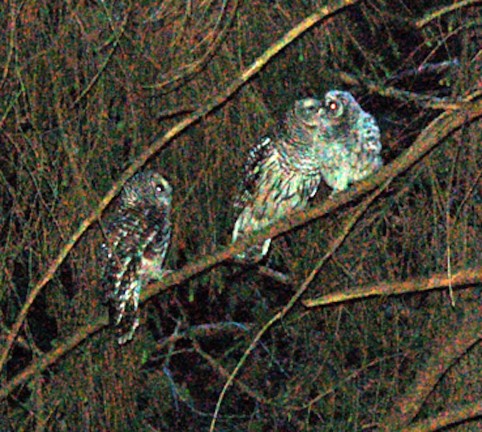
After
that, I started to observe Wollet more respectfully. I held my breath
as he first perched on the rim of his nest box, stretching his wings one
by one. The following week, I got to witness his early explorations as
he wobbled out along thin high branches, focusing intently on every
step, then wobbled successfully back to home base. A few days later,
Wollet started hopping from one high branch to another in the dense
forest.
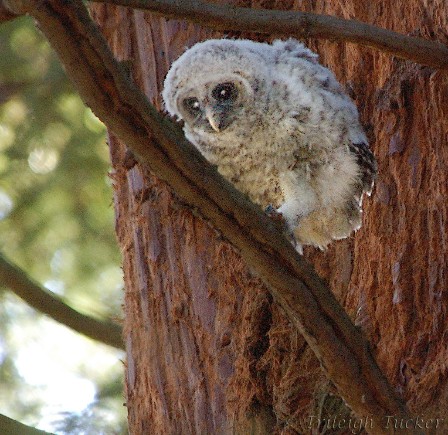
One
evening, some friends and I witnessed Wollet fall, fluttering from
perhaps forty feet up. We couldn’t see either of his parents. This time
he was on his own.
We breathed again as he bounced right back up and, looking nervously at his small but mesmerized audience, trundled away from us across the forest to a tall Douglas fir. As he hiked, his parent flew in, seeming to supervise and encourage him, watching for danger.
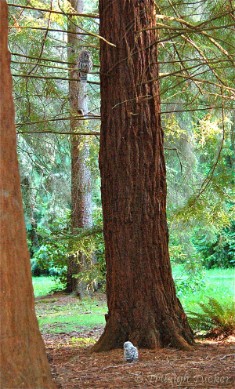
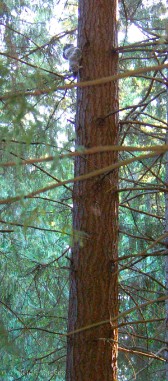
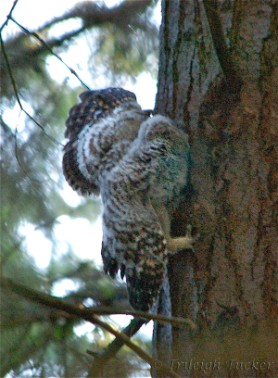
After pausing for a moment at the base of the tree, looking upward,
Wollet began to climb. And climb. The charming fluff on his legs covered
small, hardened muscles. Over and over, he sank his talons into the
tree’s thick bark, then used his wings in a way I’d never have
anticipated: to hug the bark, giving him enough purchase to allow him to
move his legs slightly higher. At one point Wollet hooked one wing over
a short side branch, using it as a brace to haul himself up. The owlet
made his slow way straight up the trunk, bypassing several potential
resting spots. Eventually, forty feet up, he tree-hugged his way
sideways around the trunk to stop on a short horizontal branch, where he
preened himself and then slept.
It began to look like the curmudgeon from a couple of weeks earlier
might have been right about how young owls develop their muscles. For
all of Veronica’s and my efforts to help Wollet—not to mention those of
the Parks and Recreation Department carpenter, the cherry-picker, and
all the guys in hard hats—I had to agree that we may actually have been
interfering with his evolution-honed growth process.
Over subsequent weeks, it became harder to find Wollet as his range
expanded. Every week or two I’d catch a glimpse of him, usually with a
parent nearby. Every so often I’d find a fresh owl pellet, a gray
package of the indigestible bones and fur of a single mouse, and wonder
whether it might be the regurgitated remains from one of his meals.
Occasionally I located him by his distinctive “I’m hungry” whistle, as he called to a parent for food. I worried about him one day when I caught him gnawing on a branch. Was this normal, perhaps for young owls to strengthen their jaw muscles? Or was he starving? None of my birder friends seemed to know.
* * * * *
“Well, I don’t really care if he lives,” said Johnny, another forest
friend and a seasoned professional naturalist. He had come up while I
was kneeling to photograph some prey remains; I couldn’t tell whether
they represented the meal of a coyote or an owl.
I interrupted him: “Yes, I know, barred owls out-compete spotted owls
in the wilderness. But there were no spotted owls in this city park.”
Although Johnny’s lined skin and worn clothes made him look like one of
those guys who live secretly in the park, he talked like a textbook
reads, and I knew he was held in high regard by other local natural
scientists. Still, I didn’t really want to hear Johnny’s ecological
rationale for why it’d be all right if Wollet died.
“But there used to be many screech owls here,” Johnny insisted. “Did
you know there’s just one nesting pair left in this area? Barred owls
really do damage the ecology of a place when they invade. The fewer, the
better, in my opinion. One reason I’m a good scientist and get all
these gigs with the Forest Service is that I don’t let my emotions cloud
my scientific judgment. Maybe regular people can get all soft and fuzzy
about dewy-eyed animals, but scientists can’t do that.”
I could feel my language shift to match Johnny’s science-talk; my
community of university scientists gives one a great deal of practice in
credibility competition. “Well, now, wait a minute. I’m a
scientist”—ignoring Johnny’s skeptical glance at my garb, since neither
of us was going to win any Scientist Fashion Awards (Oxymoron
Division)—“and I understand just as well as you do how important intact
ecosystems are. And I also know how much damage invasive species can
do.” As I was talking, Johnny’s eyes glanced upward briefly, following
some bird across the sky. “But I’m also a human being, and humans become
attached to individual creatures. That’s not a bad thing.”
“It is a bad thing, if it distracts you from thinking of the whole
ecosystem. Why is your baby owl more important than the screech owl baby
who can’t compete with him? Or even worse, gets eaten by him?”
“Okay, so this particular barred owlet isn’t more important in some
generic scientific sense,” I admitted. I didn’t tell Johnny that I had
gone ahead and named my little guy. What kind of a sentimental wuss
would he think I was? That would definitely cost me credibility.
I
continued, “But that doesn’t mean I shouldn’t care about him. I wouldn’t
care any less about a baby screech owl. I can cheer for each specific
animal’s life without losing sight of the whole ecosystem. That’s what I
call being a good scientist. If you try to keep people from caring
about particular creatures, then you eventually keep them from wanting
to learn about them or anything connected to them. It’s kind of hard to
feel affection for an abstract sort of ecological habitat, isn’t it?”
“Well, maybe, but if all they do is want to make friends”—he said
derisively—“with a wild animal that shouldn’t even get used to humans in
the first place, those people are not going to be much use when it
comes to voting on forest management issues.”
I was getting upset. In spite of my loyalty to Wollet, I knew Johnny
had a point. But so did I. I took a deep breath and scanned the woods
while I collected my thoughts.
“Well, I disagree,” I responded after a moment. “When you really care
deeply about an animal, then you learn about what he eats and where he
sleeps and what else he needs to survive. I get to ecology anyway, but I
do it by caring first and analyzing later. And besides, I remember when
you took me all over the park to show me each of those tiny little
yellow things you planted—”
“Viola sempervirens,” he reminded me.
“—and you can’t tell me you don’t care about every single one of those plants.”
“That’s just because I know the role they play in the ecology,” he declared.
“Yeah. Uh-huh,” I argued. Yes, I thought, it’s safe to care about a
flower that doesn’t have to eat other flowers to make a living. A
creature that doesn’t get nuzzled by its parents, or remind us so much
of ourselves.
“Well, have it your way,” he said. “See you later.”
I’d lost him. In a moment he’d disappeared down a trail that led into
the wetlands. Later, though, he drove his point home by sending me a
photo that clearly showed Wollet with a screech owl’s half-eaten leg
sticking gruesomely out of his beak.
Wollet learned to hunt for himself, and I could no longer count on his proximity when I spotted an adult. It also grew more difficult to recognize Wollet as he took on more adult plumage.
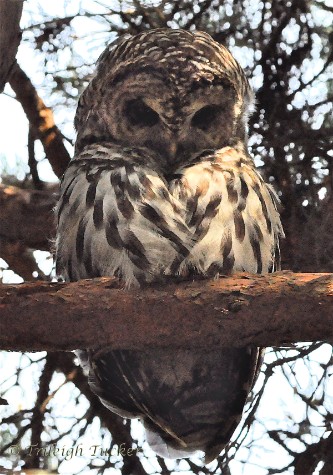
I
know that I may have had my last sighting of him—a quick glimpse as he
took off through the woods after I’d inadvertently startled him from an
unseen resting place. He’s old enough that he’ll soon leave in search of
his new territory, perhaps on one of the islands in the nearby Salish
Sea.
I’m sad. I’ll miss him. Wollet’s development was a continuing story
in my life for those months, and I can’t help being disappointed that I
won’t learn what happens next. But Wollet’s story has helped create my
own. I’m changed because of my time with him.
And there you have it. You fall in love with one small feathered creature, and it connects you to trees, and mice, and mice’s habitat, and its own expanding range of forest, full of light and shadow. A forest that’s losing one more species, whose last members’ lives now build the bones and beak of a growing predator. One young owl in a forest, and a forest in a young owl.